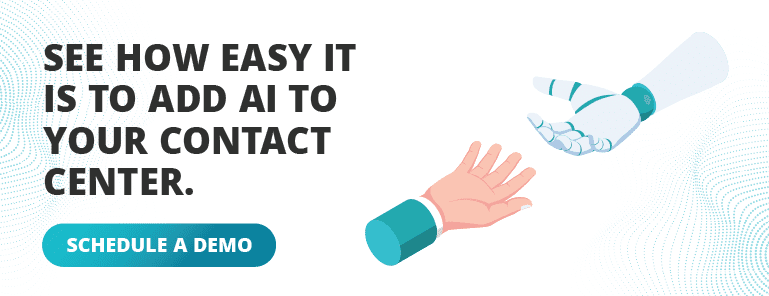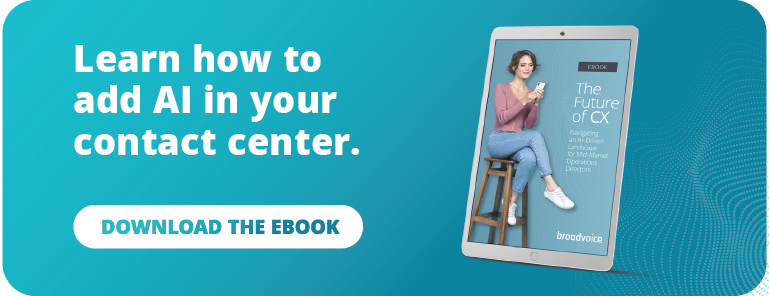Picture this: You run a bustling contact center where calls, chats, and emails are pouring in at all hours of the day, most days of the week. But it’s okay because it all just…flows. Your agents are problem solvers who use real-time insights they have at their fingertips. And customers reach out through their favorite channels only to be met with seamless, personalized support. No, I’m not living in a dream world. This is what a modern contact center, empowered by digital transformation, should be.
So, what is digital transformation? Great question, because as with everything in the contact center world, it’s changed over the years. A few years back, digital transformation simply meant moving from a clunky on-prem system to a basic cloud solution. And while that’s still super valuable, that’s not all we’re talking about here. Instead, we’re looking at how to use advanced capabilities (read: AI, advanced analytics, interactive routing and workflows, etc.) to create obviously awesome experiences over and over.
What is Digital Transformation (And Why Does it Matter?)
To level set, let’s answer the question: What is digital transformation? The long-winded answer is that it’s the process of integrating advanced digital tech into every single facet of an organization, fundamentally changing how it operates and delivers value to its customers. Or, in other words, it’s using modern tech (efficiently) to help your entire company improve operations and customer experiences.
In the contact center, it means using technology to make every customer touchpoint obviously awesome. It connects everything, from call routing to self-service solutions to real-time insights that inform every customer interaction.
So why should you, as a contact center leader, care about digital transformation? Simple. Customer expectations are on the rise and traditional methods just don’t cut it anymore. With digital transformation, your team can evolve from being reactive to proactive. (I know, that’s the dream, right?!) At the same time, you’ll reduce operational costs, improve efficiency, and keep both agents and customers happy. In short, it’s a must-have if you want to stay competitive in an increasingly digital, customer-centric world.
Understanding Digital Transformation in the Contact Center
Okay, okay, I know what you’re asking. “What is digital transformation for my customer service and experience?” Simply put, it’s using tech to make your interactions more seamless, efficient, and satisfying for your customers and your agents. Here’s what that means in practical terms:
- Streamlined customer interactions. Through automation and AI, your team can handle inquiries faster. You can route customers to the right resource on the first try, which then leads to happier, more loyal customers. (And fewer burned-out agents.)
- Easier omnichannel engagement. Today’s customers reach out via phone, chat, email, and social channels, expecting continuity no matter the platform. With omnichannel platforms, your agents have a 360-degree view of each customer, letting them interact easily across channels.
- Workflow automation. Digital transformation reduces friction with automated workflows. This includes AI handling routine requests and freeing agents to manage complex issues. Not only does this lighten the agents’ workload, but it also improves response times and consistency.
With tech solutions like AI, analytics, cloud systems, and integrated communications, digital transformation reshapes your contact center operations and maximizes productivity. It’s not just a back-end overhaul; it’s a pathway to customer satisfaction, loyalty, and ultimately, competitive advantage.
The Benefits of Digital Transformation for Your Agents
Digital transformation does more than improve customer outcomes. It supercharges your agents’ roles as well. Here’s how:
- Increased efficiency. Automation takes repetitive, mundane tasks off agents’ plates, so they can focus on solving unique, valuable issues that take a human brain to problem solve.
- Improved training and onboarding. Digital tools support a more streamlined, data-driven onboarding experience, offering new hires easy access to knowledge bases, workflows, and customer insights. Then, leaders (like you) can use the tools to continue ongoing coaching and training without digging through miles of spreadsheets.
- Access to real-time data. Agents get the data they need when they need it. Whether it’s customer history or product information, they’re equipped to deliver the fast, personalized service your customers expect.
- Reduced friction. A seamless digital environment reduces toggling between systems, allowing agents to stay focused on the customer without distractions.
Digital transformation isn’t about replacing agents. Instead, it’s meant to empower them with tools and insights that elevate their role from reactive problem solvers to proactive customer experience champions.
The Pillars of Digital Transformation in the Contact Center
The tech powering digital transformation can be distilled into four core pillars:
1. Automation
From robotic process automation (RPA) to AI-driven bots, automation offloads repetitive tasks like ticket creation, routing, and data entry. Automation also ensures that your customers get consistent, efficient support. AI can handle FAQs, while human agents focus on high-value interactions.
Practical Tip: Start small—automate repetitive, high-volume tasks first, like scheduling or simple FAQs, and expand from there.
2. Data and Analytics
Data is the backbone of any digital strategy. By analyzing customer behavior and trends, you can predict needs, personalize interactions, and improve service delivery.
Practical Tip: Add real-time dashboards or wallboards to keep everyone informed. Then, give agents analytics training so they can use data in decision-making.
3. Omnichannel Communication
Your customers expect a seamless experience across channels, from phone calls to social media. Omnichannel platforms are the only way to do that. They connect all touchpoints and give agents access to full customer histories, while also helping them respond consistently across channels.
Practical Tip: Train your agents in omnichannel skills to help them understand when and how to shift between channels and manage cross-platform conversations.
4. Cloud-Based Solutions
While moving to the cloud used to be the end goal, that’s just not the case today. Going digital means choosing cloud platforms that integrate with other digital tools. The idea is to give your agents a truly connected workspace.
Practical Tip: Choose cloud platforms that are intuitive and integrate easily with other contact center tools, allowing agents to work from anywhere while maintaining quality.
Building a Digital Transformation Strategy for Your Contact Center
Digital transformation doesn’t happen overnight. Building an effective strategy means taking a structured approach with clear objectives and thoughtful implementation. Here are three simple steps to help you build your digital transformation strategy.
Step 1: Set Clear Goals and KPIs
Define what success looks like—whether it’s faster response times, higher customer satisfaction, or improved agent productivity. Setting specific KPIs will help you measure the impact of digital tools on these areas.
Practical Tip: Track metrics like first contact resolution (FCR) rates and customer satisfaction (CSAT) scores to gauge success and identify areas for improvement.
Step 2: Create a Phased Rollout Plan
Trying to overhaul your entire contact center at once is a recipe for chaos. Instead, add modernization initiatives in phases. Start by prioritizing areas with the highest impact on customer experience and agent productivity.
Practical Tip: Get started with a pilot program for each new tool. Use agent feedback to refine the approach, ensuring a smoother rollout for the entire team.
Step 3: Add a Feedback Loop
Involve both agents and customers in assessing digital transformation efforts. Collect feedback on new tools and workflows, making adjustments based on what’s working and what’s not. Doing so will help you ensure your digital transformation strategy is adaptable and responsive to your real-world needs.
Practical Tip: Create a regular feedback cycle where agents and customers can submit insights. Keep them informed on how you’re applying this feedback to create a culture of continuous improvement.












